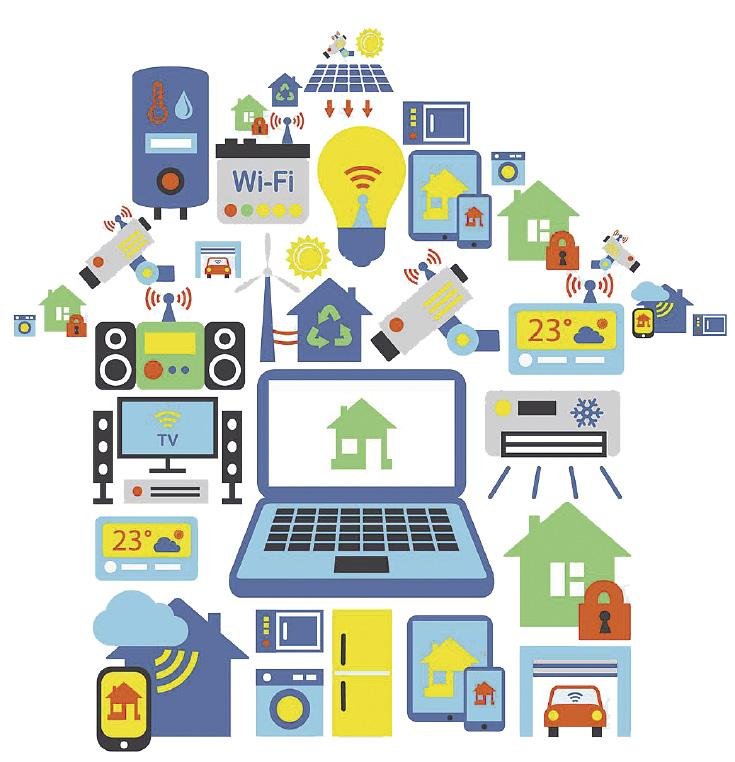Smart homes Smart homes

The idea or concept of smart home is not from yesterday morning. It has been very frequent in science fiction for a long time. And the real attempts to build smart homes are not new: if appliance manufacturers have been working on the concept of home automation for decades.
However, until recently, domotic projects have not been very successful, mainly for two reasons: on the one hand, each producer tried to develop its complete and own home automation system, which was expensive; on the other hand, technology and homes were not prepared to cover certain needs of home automation systems, especially of interconnectivity and interfaces of devices, which required an express development and installation.
Domotic systems are complex and require additional devices or technologies such as sensors (for measurement and detection of temperature, movement, light, humidity, etc. ), actuators (motors, switches, etc. ), a controller that allows programming and actions through an interface (for receiving and sending signals from such devices), a communications bus (controller, sensors and actuators) and an interface (controller and emission orders).
Communication systems between more suitable devices
When the first attempts at home began, one of the biggest problems was communication between devices. Wireless communications systems were not so developed and communication between devices was done through PLC (Power-Line Communications) systems. These systems use current cables and electrical signals (in another frequency and with little intensity) for messages between devices. One of the oldest and most used systems was the X10 and had many problems: filters are needed to avoid interference with neighborhood systems, the protocol is slow, it is not encrypted, as the distance increases can slow down and lose the signal… Since then other better PLC systems have appeared, such as UPB (Universal Powerline Bus) and HomePlug, which have not been extended. Other systems, such as the C-Bus, require specific cabling, making them more expensive and complex.
At present, however, there are wireless technologies that do not require special cables or installations and we use them daily: Wifi, Bluetooth… They can also be used (and used) in current home automation systems, since they are more suitable and easy for home automation than PLC or other systems (if they have encryption, they do not need installation, etc. ). However, specific wireless communication systems have been developed for home automation. In fact, systems like WiFi are designed for fast and massive data transport, with high frequencies and high energy consumption. The systems developed for home automation are designed for the characteristics of this type of communications: low bandwidth, long energy autonomy (some systems, such as ZigBeek, have up to two years of battery life)… Examples of this are ZigBee, Z-Wave and EnOcean. There are systems that can use electricity cables and radio signals, such as Insteo. And also others who can use electricity cables, own wiring, radio signals, infrared and Ethernet network as KNX.
Devices of all kinds, controllers and interfaces
Currently there are different types of sensors and actuators for home automation: thermostats, lighting, blinds, opening and closing windows, locks, garage doors, watering, presence detectors, alarms, cameras, door and window sensors, televisions, sound detectors, music and video players… Each of these devices uses some of the aforementioned communication systems. On the other hand, it is possible to control more and more appliances (refrigerators, washing machines…) through one of these communication systems.
As for controllers, there are numerous systems on the market: HomeSeer, Control4, Crestron, SmartThings… and Insteon also has it. To communicate with sensors and actuators, one or more of the communication systems mentioned above can be used. The more communication systems are compatible, the more options for choice of sensors and actuators. The functions offered by these controllers are to program the devices (to perform actions depending on what they receive from the sensors, time or other parameters) and give orders to the devices.
Finally, there are controller interfaces. Some controllers include the interface in touch mode or screen plus keyboard. But many of them can also be controlled from a PC or mobile device, through some application, because today we all have it and are used to using it. In this way, the controllers are cheaper, we can control the system when we are away from home... Finally, there are also voice interfaces.
Therefore, the purchase of a home automation controller and other devices allows the automation and control of the home today. The possibilities offered are endless: put the heating one hour before you get home or get up from the bed; have the hot coffee ready for breakfast time; see the children from work while performing the housework; turn on and turn off the lights during the holidays and open and close the blinds automatically so it looks like they are at home; listen to an alarm at home and send us an e-mail; turn off the lights of the rooms when there is no one…
These systems will expand in the coming years, and soon, this kind of thing will seem to us something habitual, many of the things we do with the phone, before unthinkable, as we are now habitual. In any case, the security of our computer and other devices should be more serious than until now and forget the passwords “1234”, because if not, any hacker will make us a poltergeist!
Buletina
Bidali zure helbide elektronikoa eta jaso asteroko buletina zure sarrera-ontzian











